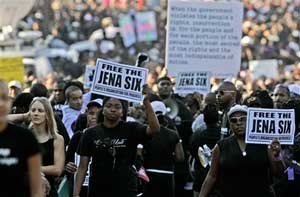Jena, La.: 'It felt like history in the making'
By
Dianne Mathiowetz
Jena, La.
Published Sep 23, 2007 11:22 PM
Sept. 20—There is probably no way to determine the exact number of people
who filled the streets of Jena, La., for more than 12 hours today.
It was both a work and a school day in this small town in rural Louisiana, far
from any major population center and accessible mainly by a two-lane road. Yet,
from dawn until dusk, the scene in downtown Jena was one of an ever-flowing
crowd of people wearing black tee shirts—people of all ages but of one
mind: to demand justice now for six African-American teen-agers whose
prosecution for a schoolyard fight with a white classmate illuminates the
racial disparities endemic to the U.S. justice system.
It is clear to all that many, many thousands gathered in Jena. Was it 100,000,
as some say? It was impossible to count them all, but for sure those tens of
thousands came representing hundreds of thousands; came demanding justice for
the millions of African-American people throughout the country who suffer daily
from racial discrimination, national oppression and racist profiling.
|
Bryant Purvis, right, one of the Jena 6.
|
During the huge turnouts of immigrants in the spring of 2006, when millions at
May Day demonstrations throughout the U.S. demanded dignity and human rights,
the corporate media, as usual, was oblivious to the massive mobilizations
taking place in communities of color. Jena is no exception.
Arrogant in their ability to define what is news and confident that people have
been rendered incapable of acting in their own interests, the major television
networks and newspapers scrambled to catch up with these historic actions.
A vital element is the role of the radio talk show hosts whose programs aired
the issues concerning the community.
Michael Baisden, Tom Joyner and other nationally syndicated radio personalities
played a major role in alerting Black communities across the country to the
situation that was unfolding in Jena.
Many youth, especially on the campuses of historically Black colleges and
universities, became educated about the case through the Internet. Many blogs
aroused students to mount demonstrations and rallies and teach-ins on their
campuses as schools came into session this fall. The Color Of Change activists
harnessed this technology to blast the case all over cyberspace.
Certainly the support of Rev. Al Sharpton and his National Action Network, Rev.
Jesse Jackson, the American Civil Liberties Union, the Nation of Islam, the
NAACP, the Southern Christian Leadership Conference and other national
organizations and famous personalities were important in bringing the case to
light and persisting, despite the lack of interest by the corporate media.
What was apparent when watching the mass of people in Jena was the grass-roots
character of who chartered and filled the hundreds of buses. The organizers
were first-time demonstrators from colleges and universities; union members
from Detroit’s auto plants and Teamsters from Atlanta; church women,
Black businesspeople, parents, and neighborhood activists mostly from towns and
cities across the South but also from the Northeast, Midwest, Southwest and
West Coast.
Carloads of families and friends drove for hours, bringing children so they
could be part of “making history.”
Grey-haired seniors who had experienced the terror of Klan night-riders and
lynchings during the 1960s; residents of New Orleans and the Gulf Coast who
have survived criminal neglect and injury by the government during Katrina and
Rita; mothers and fathers who can never escape worrying about whether their
children will be victims of police brutality, all melded together in the
courthouse square, in parks where parallel rallies were taking place, and along
the streets in front of shuttered businesses.
The slogans on two of the most common signs explain why the protest defied all
expectations: “Enough is enough” and “We are the Jena
6.”
Distrust of the justice system, the presence of inequality every day decades
after the passage of civil rights legislation, the ever-looming possible loss
of employment, housing, healthcare and education, and the weight of endless war
and occupation caused an eruption from below.
It was a remarkable day, not just in Jena but everywhere else that people
rallied and marched in solidarity, wore black to work or school, and talked
about organizing to make a change.
Will Jena mean the same for this generation that Montgomery or Selma meant for
the millions decades ago who broke the back of Jim Crow segregation? That story
is yet to be written by those who on Sept. 20 marched and rallied, listened and
chanted, taught and learned from each other that a movement is when the people
MOVE in an unstoppable journey toward freedom.
The writer is an organizer of the International Action Center in Atlanta,
Ga.
Articles copyright 1995-2012 Workers World.
Verbatim copying and distribution of this entire article is permitted in any medium without royalty provided this notice is preserved.
Workers World, 55 W. 17 St., NY, NY 10011
Email:
[email protected]
Subscribe
[email protected]
Support independent news
DONATE


